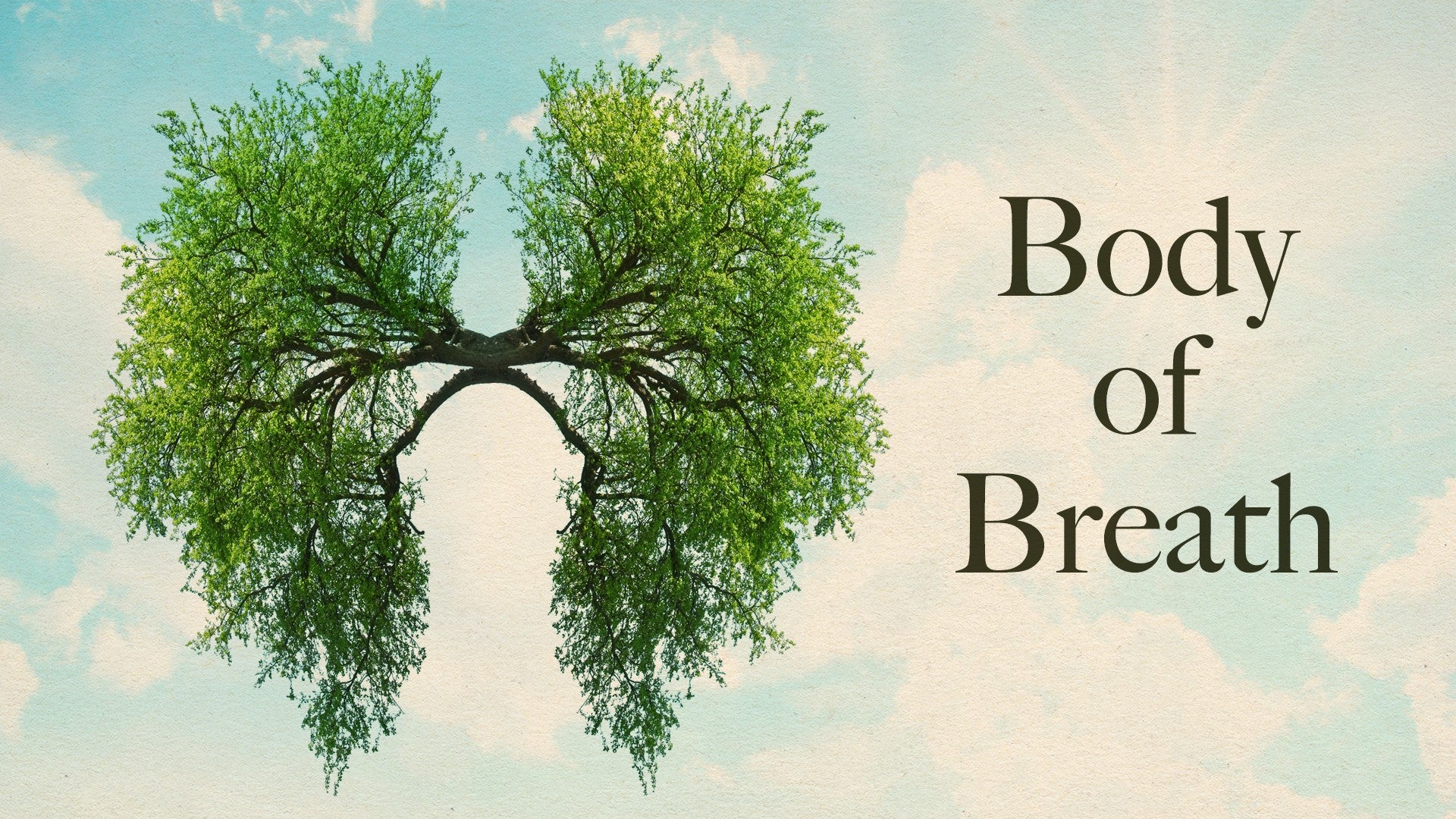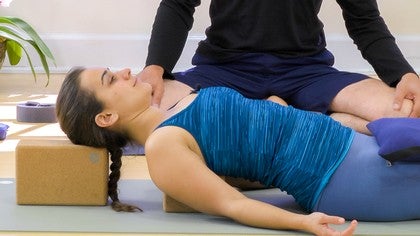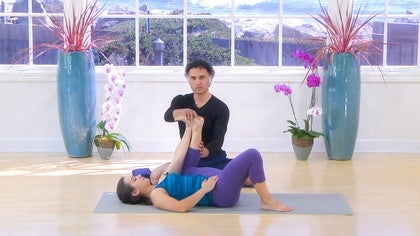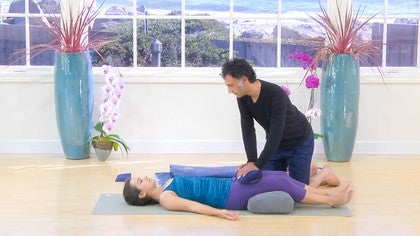Description
About This Video
Transcript
Read Full Transcript
So in our past three classes, Juno and I have been showing you different aspects of the body, different parts of the breath, concentrating on the belly, on the ribs, on the diaphragm, and the upper chest, specifically the collarbones. But of course these all exist at the same time, they're all happening in your body and now we're going to see how we can begin to put those all together, find the integration between the belly, the chest, the diaphragm, find the relationship. So if you would start lying on your back and placing the sandbag under your hands, extending your arms overhead quite strongly, extending the legs, keeping the feet flexed. So this very simple pose does many of the aspects we've been looking at. It creates a softness in the belly through the extension of the side body, bringing attention to the diaphragm, to the ribs. Notice if your ribs are sticking up a bit, maybe you can let them settle slightly. In the opening of the shoulders, you can use the mat to get awareness of the back body, letting the shoulder blades be broad as we were looking at in so much detail in the previous class. Just let your your body settle in this pose, keeping the arms and legs quite strong for the moment, allowing the torso to be as easeful as possible. And as you spend a bit more time in the pose, you can begin to lessen the effort in the legs, lessen the effort in the arms. And notice that just calming the body, finding your breath. You can spend as much time in this pose as you like as the entrance to this practice, but right now we're going to take the sandbag away and simply bend the knees and come into constructive rest. Reminding ourselves of the three aspects we've been looking at, placing your hands on your lower belly, even a bit lower, feeling the rise and fall of your belly. Noticing whatever sensations you may feel there. Very sensitive area, very powerful area too. So things come up when you begin to work your belly, observe your belly as we discussed in the earlier class. So be receptive to that, but be generous to that. Then moving your hands to the front of your ribs, making sure the palms can also feel the side body, feeling the movement, feeling the sideways expansion of your chest as well. And then using the sensation in your back body on the mat to see if there's any movement in the in the back. So ideally in all of these three places we're looking at, the bowl of the pelvis, the circle of the diaphragm and sort of circumference of your shoulder girdle. We want this equal expansion, all sides, all directions. And as you line this pose, looking at the whole torso, you may naturally notice where your breath is constricted. We often look at where we find the most sensation and you can also look here where you feel the least sensation where there may be the least movement in your body. And as a reminder, the eye pillow is always a useful aid to just place on your body if you want to bring a bit more attention to any part of your breath. So bringing your right ankle to your left knee and bringing the legs in, taking hold of the back of the thigh or the shin. Starting with a few simple hip openers. You can do this keeping the feet flexed, getting a sense of a drawing in of both legs, drawing into the pelvis, feeling the sensations in the hip joints, in the back of your pelvis, feeling a broadness. You see June is slightly rocking here. It's always a nice movement to do to bring a bit more awareness and a sense of broadening of the back of the pelvis and ease in the sacrum. So uncrossing the legs, pausing just for a moment and taking the other cross, keeping the feet flexed, drawing the legs in, but keeping the belly soft. Then releasing the legs, taking the right leg into happy baby, taking hold of the outside of the foot, using the hand to support the leg, letting go of all of the muscles and seeing if that can allow the leg to fold a little bit deeper. All the time keeping your observation on your breath. All these classes are about the breath, specifically in this last one where we're looking at the breath through the whole torso. In the hip openers, see how it feels with the breath in the hip, but also notice your rib cage, your collarbone and the sense of communication that happens through the whole torso with each inhalation and exhalation. So releasing that leg, pausing for a moment and taking the left leg. So knowing that this is Juna's hip that has a little bit more congestion in, you can stay a bit longer on the side that you know has has more tightness or maybe a little bit, if it has a little bit more pain, make sure you back out of it a little bit and then perhaps stay a bit longer. You're not pushing into the pain. Again, feeling where the breath is moving and importantly where the breath is not moving.
So releasing that leg, pausing for one moment, then rolling over to one side and coming on up to downward dog, keeping the knees bent if you need to. But remembering from our first class on the belly, this is a great pose to get that sensation on the exhalation of the lifting of the floor of the pelvis, the whole contents of the pelvic bowl and that sense of lifting, carrying through the torso into the collarbones. So pay specific attention to the exhalation in this pose for this purpose. So we can use these poses for many different purposes. Today, downward dog, we're going to use to get the sensation of the hollowing of the belly and coming down to your knees, sitting back on your heels for Vajrasana. Now this pose may be a little uncomfortable for you, maybe you don't have quite the openness in your knees or the top of your feet feel painful. You can take many different props to work with this, you can take a block and sit in Virasana. So Virasana you can do with a brick if you want to just kneel up for a moment and taking the brick, putting it between your ankles and coming down to sit. You can use one brick, two bricks, whatever you need to have ease in your knees. So sitting here, closing the eyes, finding the grounding of the thighs, bringing your attention to your belly, noticing the inhalation, encouraging the inhalation deep into the base of the pelvis. And as you feel the inhalation filling up in the base of the pelvis, the whole circumference of the pelvis, see if you can find the connection that rebounds back through the torso, lifting the collarbones. So you get this sense of grounding and also this sense of lightness, sense of lengthening through the torso. Every inhalation you take the spine gets a little bit longer, which means the whole cavity of the torso will get longer too. So you might want to sit here five or ten minutes to a very simple breath observation meditation. If any of these versions of Vajrasana-Virasana with the blocks is still not comfortable, you can sit in a simple cross-legged seat. When you feel you have sat for long enough, you've had your meditation, you found some observations, we'll move into the next phase of the sequence. So sitting up, taking the block away and coming forwards into child's pose with the arms extended forwards. Letting this pose bring your attention to the whole back body. So when you're looking at the breath, looking at the expansion of the whole torso, to remember the back body is just as important. We can spend a lot of attention, our belly coming up, the front of our ribs, our collarbones and quite forget the back of our body. So pausing here for a moment, noticing any movement, any sensation in the back body. Then taking the block between the hands as we have done before and bringing the block towards the shoulder blades. Keeping some strength in the arms, pressing the hands together. Feeling the subtle change in sensation front and back of the body. We're putting more pressure on the palm, on the thumb side, more pressure on the pinky side.
And bringing the block back down to the ground. Crawling your hands over to the left side, keeping the right sit bone very heavy. So not moving the pelvis but you're finding this opening and length through this whole side body, through the shoulder, through the arms, all the way into the fingers. Pausing for a moment, noticing how this helps open up the side body. But also how does this make the breath feel in the belly? How does it make the breath feel in the upper chest? Maybe going a little bit deeper into this pose before you come out. So crawling the fingers just a bit further around. And then coming back to the central position. Pausing there for a moment and then begin to bring the hands round to the other side. Keeping that thigh bone firmly anchored. Feeling the opening in the side body here. But then bringing the observation to the hole of your torso. How does it feel from the pelvis through the torso to the top of your chest? And bringing the hands back around to center. Coming back to sit in Virasana, Vodrasana. Whichever position you like for a little bit more of breath observation. This time placing the hands strongly at the root of your thighs. And with inhalation, a bit of pressure with your hands. And you can vary this as much as you feel you need. You can do this quite physically. Really using the drop of the thighs, the breathing down into the belly to encourage this lift of the chest. If you're finding it a bit difficult to get in touch with that, all you can do it is a very, very simple movement. Just the minutest bit of pressure of the palms on your thighs. So we know from the other three classes for Juna, it was hardest for her to bring her attention and movement into the upper chest. So you might want to use a bit more physical effort to start with to feel that sensation, even if it may be a little bit forced. And then see if you can connect to that on a subtler level. Now let the arms rest. Just the vaguest sense of pressure on the thighs. Try and find a sense of the torso filling up from the inside, not necessarily the lift of the collarbones, but the collarbones being lifted by the inhalation. So pausing once again for a few minutes of breath-centered meditation. But unlike the other classes we've been doing, try and get a sense of the wide view of the breath, the breath through the entire torso. Remembering that includes both the front and the back of the body. You might want to take five, ten minutes here observing your breath, seeing if you can find the connection between the inhalation coming deep into the lower belly and that rebounding back through the entire torso, the lengthening of the spine and the lifting of the upper chest.
Coming out of the meditation, opening the eyes slowly and receive what is in front of your vision. Don't try and suddenly grasp on to whatever you may see. Just sit quietly, this transition phase between what we are calling a formal seated meditation and then moving out of it. There's that moments, few minutes where you want to make that change very soft and very subtle. So let's look at Gaurudasana once again as we've done before. Twining the arms, bringing the palms together, lifting the elbows. And again with this pose we were looking specifically at parts of the body but see if you can find a sense of the lifting of the elbows, lifting the whole shoulder girdle up, finding length through the torso without forgetting the grounded nature of the dropping of the thigh bones, the grounded nature of inhaling deep into the belly. Again finding that connection through the torso from this sense of grounding that then allows this lightness and lift. Releasing the arms, interlacing the fingers, taking the arms overhead. We're keeping the throat very soft. One thing that happens when we begin to bring too much attention to the lifting of the collarbone, the lightness in the upper chest is we begin to force it and start to tighten the neck which defeats a lot of the purpose of that. So keeping the neck soft and seeing if you can lift the whole shoulder girdle up, maybe around the neck. There you go. And feeling the origin of this lift starting from deep in the belly. Bringing the hands back to your side.
This time interlacing the fingers behind, taking the arms up. And bringing the hands back down to your thighs. Pausing for the last time to take advantage of this awareness that you're cultivating in your body, the awareness in your belly, in the entire torso, to sit in meditation and observe those sensations. Each time you sit in a sequence, try and make those observations quieter and quieter. You may want to just feel whatever sensations are arising now in any parts of the torso rather than drawing your attention to any specific parts. It can be interesting just to notice these arising of the sensation and it disappears and it comes up somewhere else. Just as our mind in meditation will flit from place to place, these sensations in our body are often doing the same thing. And if we can quieten our body enough to observe those carefully, they begin to settle too. Just as the mind begins to settle and observe in meditation, the sensations in the body too begin to quieten, get more and more subtle. And we're going to finish this practice, this very simple practice we've done today, really based in observation much more than doing many asana. We're going to finish in shavasana. And I suggest today you make this shavasana a little bit longer than you normally do. If this is something you may do for five or ten minutes, I would suggest today, see if you can allow yourself to recline in shavasana for at least 15 minutes. It's taking a moment to set yourself up as you're going to be here for a certain amount of time, crossing your arms across the body, taking hold of opposite shoulders, little roll from side to side, feeling that broadness, that filling of the back body as we've looked at before. Then gently releasing the arms, placing the arms the side of the body, a good six to eight inches apart, letting the shoulders be wide. You might need to tuck the buttock flesh under a little bit to get an extra lengthening through your back body, readjusting the arms, readjusting the broadness in the shoulders. Another nice alternative is to have a bolster. So we're going to get a bolster to place under the knees, bolster placed under the thighs, creating ease in the lower back, allowing the head of the thigh bones to drop, which you can increase further by taking a sandbag and placing it on the head of the thigh bones. Feeling that weight, letting the thigh bones settle, letting the belly be soft, opening the throat. So I suggest you press pause, recline in Shavasana for as long as you like. Try and make it at least 15 minutes and then rejoin us when you're ready to come out of the pose. So these props we're using today, if you don't have them, they're really not needed, but they can add an extra dimension, an extra sense of ease if you do have them. One important thing to remember when you're coming out of Shavasana, especially if you've been there for some time, is to do it in stages, to do it gently, the same way as I was talking about coming out of meditation. Make this transition phase very gentle, very smooth. So you may want to start by simply moving your fingers, moving your toes, slightly reanimating your body, bending one leg then the other leg, keeping your attention on your breath, keeping your attention on how the breath is changing as you begin to move your body again, then rolling over to one side. You might want to take your arm as a pillow to rest your head on, making sure you pause here for a good three, four, five breaths, and using your left hand, pushing into the ground, letting the head be very heavy, and then coming on up to sit. So this is the end of these series of classes. Juna and I have been showing you looking at the breath, breaking the breath down into these three parts of the belly, the diaphragm, and the side body, rib cage, and then the upper chest and collarbones, and finally integrating them all together. So as you do this class, maybe you'll do it again, you'll find more and more subtle observation in your body, but let us know how that feels, how it feels for you, how it changes, what you're learning about your body. We're always interested in hearing how students around the world are experiencing the practice of yoga.
Body of Breath
Comments

You need to be a subscriber to post a comment.
Please Log In or Create an Account to start your free trial.







